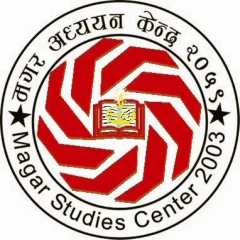Hagon, Tony (1951). Nepal the Kingdom Himalayas. Berne witzerland : Kummerly & Frey, Geographical Publishers. Annotation by: Gupta Bahadur Rana
Hagon (1951) has described about Racial and Ethnic diversity of Nepal. In page 68, he mentions about the Magars: “The Mangars are the westernmost of the larger ancient Nepalese ethnic groups; the miscellaneous minority groups of the Rukhas and the Buras, to the east of the Saipal river, are insignificant (fig.10). The neighbours of the Gurung, the Mangars live on the western and southern flanks of the Dhaulagiri-massif. Scattered colonies are found as far afield as eastern Nepal, however, and down in the Terai aof eastern Nepal, and there is a large compact settlement-area situated in the wide sweep of the Karnani river, between Dhundras and Chhapre. The Mangars have not developed a type of house peculiar to themselves, but have adopted neighbour’s ype of dwelling-house. At the western end of the Dhaulagiri-massif and on the upper course of the Uttar-Ganga river, they live in massive houses with flat roofs, whose form is an imitation of the houses in neighbouring Tibetan settlements to the north. On the southern flank of the Dhaulagiri-massif, on the contrary in the Mayangdi valley, they build their Houses, as do the Gurungs, of drystone walls roofed with slate. The Mangars have, like the Gurungs, gained fame as gallant soldiers in British service; beside this, however, they posses considerable skill as craftsman: they are the bridge-builders and blacksmiths among the Nepalese, and the primitive mining is largely in their hands. From the more southerly regions, that is to say on the lower course of the Bheri and Karnali rivers, a great number of Mangars annually migrate to the Terai and there manufacture bamboo parries, baskets, and mats for sale in the bazaars along the borders. In their most northerly settlement, on the other hand, the important trading-centre of Tarakot on the Barbung river, they have largely adapted their way of life, their clothes, and their religion to that of the Tibetans; like the latter, they also live by the salt trade. Here there are found numerous lamaseries with Mangar lamas; in the lower zones, however, Hinduism of a tantristic tendency prevails. …… As regards the race, the Mangars are related to the Newars; like the latter, they have almond-shaped eyes or even open eyes, whereas Mongoloid eyes are very rare. …. I have already pointed out that the distribution of the races in eastern Nepal is quite different from that in the western part of the country, where the ancient Nepalese people are entirely lacking. To the west of the catchment-area of the Kali Gandaki river there live only Indo-Nepalese races and Tibetans (Bhotiyas.) Their settlement-areas partly adjoin each other, and sometimes extensive regions lying between them are altogether uninhabited. Strange to say, this fact has great economic importance; only ancient Nepalese races went as mercenaries, and so they alone had, and still have, a share in the financial property of the mercenary soldier’s life. For this reason the living-standard in the west of the country is in general considerably lower than in the eastern part.”
Harper, Ian (2014). Development and Public Health in The Himalaya: Reflections on healing in contemporary Nepal. New York: Routledge Tylors & Francis Group Annotation by: Bishnu Kumar Sinjali
This book is about Magar related issues–about the public health and health care system of Nepal in Palpa district. The researcher has explored the traditional health care, spiritual belief and modern shamans, modern medicine, pharmaceuticalization and health care system of Nepal. Being researcher’s study area Palpa district, there is several case studies from Magars are taken regarding health, and health care and described. In the book there is description of medical belief system, traditional health care, Magar Lama (shaman) and other caste/ethnic group’s Lama (shaman) and belief, local name of disease and causation of illness, worship and sacrifices for healing etc. He has also described the interesting stories of wife’s of ex-Gorkha armies or foreign employee who have infertility visited to the higher caste Lama (shaman) for treatment and that shaman has been done check-up and given treatment in private room keeping alone her; and further Tuberculosis and Magar’s belief system etc. Furthermore, he also described pluralistic healers of the district and their market and consumption.
